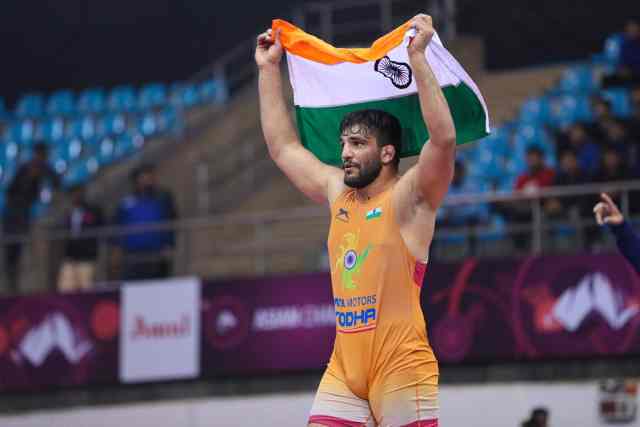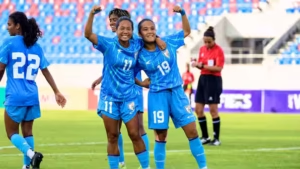Wrestling in India carries the weight of centuries of tradition. Yet, a curious pattern emerges: almost all of India’s international success has come in freestyle wrestling, not in Greco-Roman wrestling.
Names like Sushil Kumar, Yogeshwar Dutt, Bajrang Punia, Sakshi Malik, and Ravi Dahiya are etched in collective memory. From dusty akhadas in Haryana and Uttar Pradesh to Olympic podiums, Indian wrestlers have brought glory to the nation.
Despite wrestling’s deep cultural roots, India has never won an Olympic medal in Greco-Roman. By contrast, several Asian nations Iran, Kazakhstan, Uzbekistan, Kyrgyzstan, and even Japan have turned Greco-Roman into a medal factory. The reasons behind India’s lag and Asia’s contrasting success lie in cultural preferences, coaching structures, training science, and long-term planning.
Understanding Greco-Roman Wrestling
Greco-Roman wrestling differs fundamentally from freestyle. The defining rule is clear: no attacks below the waist. Wrestlers cannot use trips, leg holds, or tackles. Instead, they must rely solely on upper-body throws, locks, and clinches. This makes the style demanding, requiring explosive shoulder and chest strength, rotational core power, and impeccable technique.
For Indians, steeped in kushti where leg attacks are central this transition feels unnatural. The instinct to shoot for a leg is deeply ingrained, making Greco-Roman a stylistic misfit at the grassroots.
Why India is Lagging in Greco-Roman
Freestyle Dominance in Culture and Policy: Freestyle aligns with traditional Indian wrestling, so it became the natural pathway to international medals. All seven of India’s Olympic wrestling medals have come in freestyle. This medal history reinforces bias, federations, coaches, and families push young wrestlers into freestyle, neglecting Greco-Roman.
Lack of Specialized Coaching: Greco-Roman requires coaches trained in lifts, suplexes, and par terre techniques. In India, the majority of coaches are freestyle-oriented. Attempts to plug the gap with foreign coaches like Georgia’s Temo Kazarashvili have been short-lived and unstable. Contracts are often terminated after one Olympic cycle, preventing long-term knowledge transfer .
Infrastructure and Exposure Deficit: Freestyle wrestlers benefit from national camps, foreign exposure tours, and government support. Greco-Roman wrestlers rarely receive such opportunities. Administrative delays mean planned training stints in Russia or Central Asia are often scrapped. The lack of dedicated Greco-Roman training centers further weakens the pipeline.
Training Methodology Gap: Indian wrestlers train heavily for endurance and lower-body strength, effective for freestyle scrambles. Greco-Roman demands explosive, upper-body power. Countries that excel use sports science-based strength and conditioning programs, emphasising Olympic lifts, plyometrics, and rotational throws. India lacks such specialised regimens .
Funding and Federation Bias: Since freestyle delivers medals, it gets the bulk of funding. Sponsors and federations rarely back Greco-Roman wrestlers. Administrative instability as seen in 2023 when Wrestling Federation of India’s leadership crisis disrupted camps worsens the situation.
Psychological and Cultural Barriers: For many young Indian wrestlers, Greco-Roman feels like a “lesser option.” Without cultural pride or icons in the style, the motivation to specialize remains weak. This leads to a shallow talent pool compared to freestyle.
India’s rare highlights in Greco-Roman only underline the problem. Sunil Kumar’s bronze at the 2023 Asian Games ended a 13-year medal drought in the discipline.

At the 2023 Asian Championships, India managed only three medals in Greco-Roman compared to a dozen in freestyle and women’s wrestling. At the Paris 2024 Olympic qualifiers, India’s entire Greco-Roman squad failed to secure a single quota, while freestyle and women’s wrestling bagged multiple slots .
This record shows that India is not just underperforming the system itself is structurally incapable of producing world-class Greco-Roman wrestlers under current conditions.
Asian Nations Excelling in Greco-Roman
Iran – The Powerhouse
In Iran, wrestling is not just a sport it is a cultural emblem. Practiced in traditional zurkhanehs, it enjoys national pride and government patronage. Iran consistently produces Olympic and World champions in Greco-Roman. Wrestlers like Mohammadhadi Saravi dominate global podiums. Importantly, Iran invests equally in freestyle and Greco-Roman, ensuring balanced pipelines .
Kazakhstan – Soviet Scientific Legacy
Kazakhstan topped the 2023 Asian Wrestling Championships with eight Greco-Roman golds. Their system inherits the Soviet sports model, with scientific training, structured academies, and rigorous strength-conditioning. From youth to senior levels, athletes follow a standardized, throw-centric curriculum.
Uzbekistan – Rising Force
Uzbekistan has rapidly grown into a stronghold, thanks to specialized hubs in Tashkent and Samarkand. Their wrestlers are known for spectacular throws, nurtured through Soviet-era methodology. Government support ensures consistent exposure and development.
Kyrgyzstan – Punching Above Weight
Despite being a small country, Kyrgyzstan has built a reputation in Greco-Roman. Their wrestlers regularly win medals at Asian and World events, reflecting how structured training can outweigh population size.
Japan – Technical Precision
Japan is better known for women’s freestyle, but its Greco-Roman program is steadily improving. Through centralized training at the Ajinomoto National Training Center and youth pathways via the JOC Elite Academy, Japan focuses on technical mastery of moves like the gut wrench. Data-driven analysis underpins their approach .
India does not lack raw talent. It lacks structure, planning, and prioritization. Steps to bridge the gap include:
- Dedicated Centers: Establish at least two national centers exclusively for Greco-Roman, distinct from freestyle hubs.
- Long-Term Coaching Contracts: Hire foreign experts from Iran or Central Asia on five-year terms, ensuring curriculum reform and coach education.
- Sports Science Integration: Redesign strength and conditioning programs to focus on explosive upper-body power, rotational strength, and par terre drills.
- International Exposure: Send Indian wrestlers regularly to Iran, Kazakhstan, and Uzbekistan for training and sparring. Exposure to their techniques is vital.
- Equal Funding and Recognition: Allocate resources for Greco-Roman at par with freestyle. Showcase role models like Sunil Kumar to inspire youngsters.
- Grassroots Awareness: Introduce Greco-Roman categories in domestic tournaments and akhadas to expand the talent base.
India’s struggles in Greco-Roman wrestling are not due to lack of athletes but a systemic failure of vision. While freestyle thrives on traditional culture and institutional support, Greco-Roman has been left as a neglected sibling. Meanwhile, Iran, Kazakhstan, Uzbekistan, Kyrgyzstan, and Japan have turned Greco-Roman into a structured, medal-winning discipline through cultural integration, scientific training, and stable planning.
If India wants to compete on the Olympic stage in Greco-Roman, it must change its mindset treating it not as an afterthought but as an equal to freestyle. With dedicated infrastructure, specialized coaching, and international collaboration, India can tap its reservoir of wrestling talent to finally break into Greco-Roman glory.
How useful was this post?
Click on a star to rate it!
Average rating 5 / 5. Vote count: 4
No votes so far! Be the first to rate this post.






